Enhancing Your Kitchen: Backsplash Murals Explored
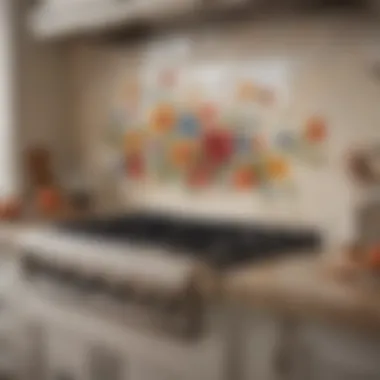
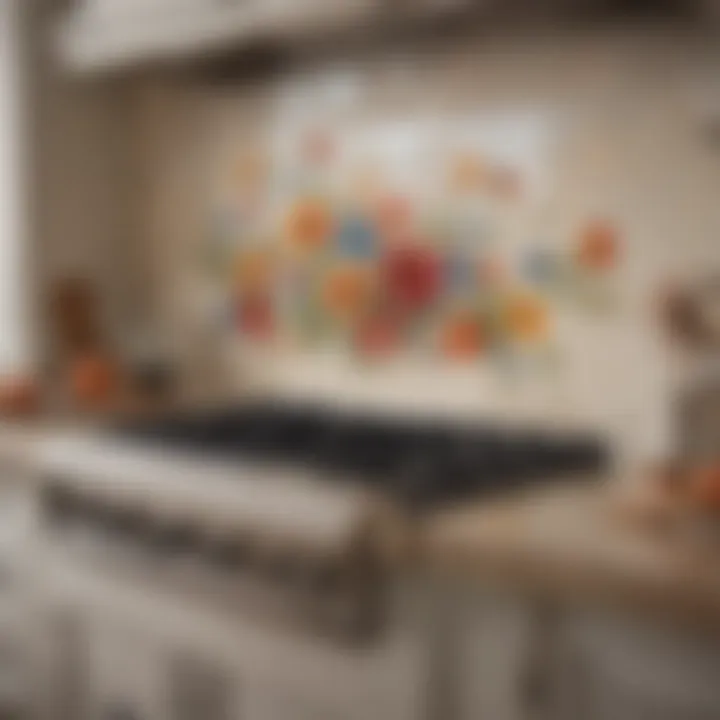
Intro
Kitchen stove backsplash murals have emerged as a significant element in modern interior design, marrying both aesthetics and functionality. These murals serve as more than just protective barriers against splashes and spills; they transform the kitchen, offering an expressive outlet that reflects personal style and enhances the overall atmosphere. In this article, we will explore the various facets of kitchen backsplash murals, focusing on their design inspiration, strategic choice of materials, installation processes, and maintenance tips. Homeowners and design enthusiasts alike will find valuable insights for creating a kitchen space that resonates with their vision.
Design Inspiration
In an age where kitchens are not just cooking spaces but also social hubs, the design of backsplash murals plays a crucial role. The choice of mural can drastically influence the mood and functionality of the kitchen.
Current Interior Design Trends
Today’s kitchen designs are leaning towards open spaces that integrate seamlessly with living areas. Murals that incorporate natural themes or abstract designs are particularly popular. Popular motifs include:
- Botanical illustrations
- Geometric patterns
- Vintage-inspired art
- Custom photographic prints
These trends highlight a move towards personalization, allowing homeowners to express individual tastes through their backsplash choices.
Color Palettes and Their Effects
Color selection for murals is equally important. It can set the kitchen's tone and create a sense of warmth or coolness. Popular palettes often consist of:
- Earthy tones: Browns, greens, and terracotta can create a warm, inviting ambiance.
- Cool tones: Blues and grays deliver a sleek and modern aesthetic.
- Bold colors: Reds and yellows can energize the space, while pastels might add a touch of softness.
Selecting the right colors also affects perception. Lighter colors can make a space feel larger and more open, whereas darker shades may add depth and coziness. Ultimately, choosing a color palette should align with both the homeowner's personality and the overall kitchen design.
"A well-chosen mural is not only about beauty; it's about creating an emotional connection within the space."
Exploring the right mural for your kitchen backsplash can set the groundwork for an inspiring and functional cooking environment.
Intro to Kitchen Stove Backsplash Murals
In the realm of kitchen design, the backsplash plays a critical role, serving both functional and aesthetic purposes. Among the various options available to homeowners, kitchen stove backsplash murals stand out for their unique ability to blend creative expression with practicality. These murals not only protect the wall from splashes but also infuse personality into the kitchen space. The importance of backsplash murals lies in their capacity to transform an ordinary kitchen into a focal point that reflects the owner's style and preferences.
When considering a kitchen remodel or an update, backsplash murals can easily become the centerpiece of the room. The variety in design options allows for extensive customization to suit different styles, whether one leans towards rustic charm or modern minimalism. Individuals can find a mural that complements their taste while enhancing the overall atmosphere of the kitchen. Furthermore, an effectively chosen mural adds depth and visual interest.
From an aesthetic perspective, backsplash murals can significantly change the dynamic of a kitchen. They can harmonize existing colors and materials while introducing new visual elements that excite the senses. This makes them an essential consideration for homeowners aiming to create engaging spaces, particularly when entertaining guests.
Besides the artistic appeal, there are practical benefits largely ignored in the design process. Kitchen stove backsplash murals contribute to easy maintenance and cleaning, as many materials are resistant to stains and moisture. This practicality cannot be overstated; busy kitchens can generate spills and messes that directly affect wall surfaces. Therefore, choosing the right mural ensures longevity while keeping the kitchen looking pristine.
In summary, kitchen stove backsplash murals serve dual purposes—enhancing the beauty of the space while providing necessary protection. Their importance in kitchen design goes far beyond mere decoration; these murals are a vital element that contributes to both functionality and style, making them worthy of thorough exploration.
Historical Context of Backsplash Design
Understanding the historical context of backsplash design is vital in appreciating the significance of kitchen stove backsplash murals today. Backsplashes have functioned both practically and aesthetically throughout history, influencing kitchen designs and trends over time. Their evolution reflects changes in culinary practices, cultural trends, and artistic expressions. This context sets the stage for modern designs and helps homeowners make informed choices for their kitchen spaces.
Early Uses of Backsplashes
The earliest instances of backsplashes can be traced back to ancient civilizations. In cultures such as the Roman and Greek societies, tiled surfaces were common around cooking areas. These tiles served not only a practical purpose, protecting walls from damage due to heat and spills, but also demonstrated craftsmanship and artistry.
In the medieval period, backsplashes adopted more utilitarian designs, often made from materials such as stone or mud. These were practical, focusing on functionality rather than aesthetics. However, as the Renaissance emerged, a revival of decorative arts took root. Tile murals began to surface, often featuring intricate designs that showcased the household's wealth and taste. The kitchen was becoming a more celebratory space, reflected in how backsplashes were treated.
Evolution of Design Trends
The 20th century brought significant changes to kitchen design, particularly with the invention of new materials. The introduction of ceramic tiles and later, glass, allowed for more vibrant colors and complex patterns. This period marked a shift where backsplashes were increasingly seen as an opportunity for self-expression.
Today, backsplash murals encompass a variety of styles, from contemporary minimalist designs to elaborate artistic representations. Trends in recent years indicate a preference for personalized designs, often incorporating custom images or artistic elements that embody the homeowner's personality. This evolution not only enhances the kitchen's appeal but creates a space that is both functional and a reflection of individual taste.
Role of Murals in Kitchen Design
The use of murals in kitchen design represents a unique synergy of art and functionality. They serve not only as visual enhancements but also as means to create atmosphere and identity within one of the most active areas of the home. Murals can dramatically transform ordinary walls into focal points, setting the tone for not just the kitchen but for the overall home experience. This section will delve into the specific benefits of murals, emphasizing their significance in contemporary kitchen design.
Enhancing Aesthetic Appeal
Murals offer an excellent way to elevate the aesthetic appeal of a kitchen. They can range from intricate designs to simplistic patterns, allowing for a vast array of choices that cater to individual tastes. For instance, a beautiful ceramic tile mural could serve as a culinary masterpiece, giving a classic yet modern touch to the space.
Additionally, murals can connect with broader themes in home decor, harmonizing with the colors and materials used in other areas. The cohesiveness achieved through thoughtful mural selection greatly enhances the kitchen’s appearance. A well-placed mural can draw the eye, captivating visitors and creating an engaging environment.

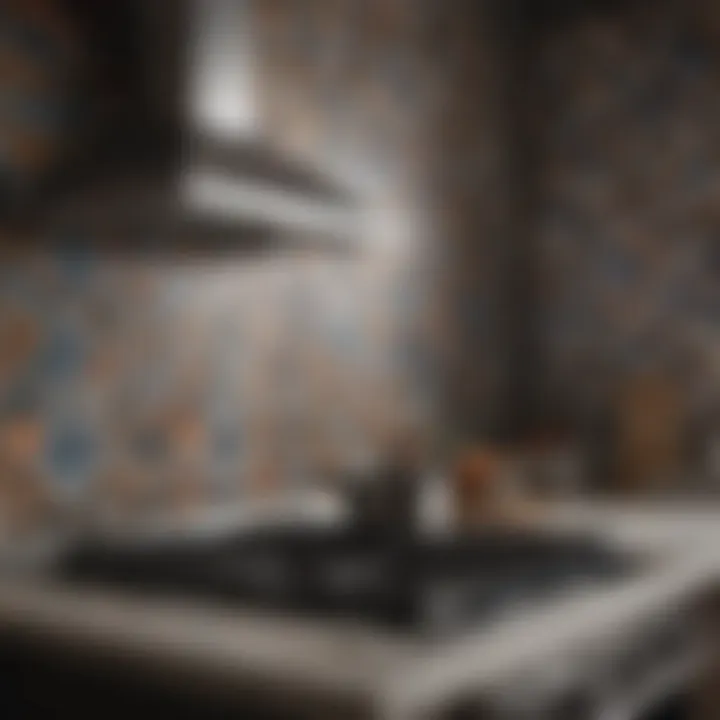
Moreover, murals can invoke emotions and memories through imagery that resonates with the homeowner’s lifestyle or culinary interests. Whether it is a rustic farm scene or a vibrant culinary still life, the right mural can evoke a sense of comfort and luxury. By replacing mundane tiles with artistic expressions, a kitchen can become an inviting space that pleases the eye and soul.
Defining the Kitchen's Personality
The personality of a kitchen is shaped significantly by design choices, and murals play a vital role in this. Selecting a mural allows homeowners to express their tastes and preferences. A beach-themed mural might reflect a love for the ocean, while a mural depicting cityscapes could highlight urban sophistication.
It is essential to consider the theme of the kitchen when choosing a mural. For example, a vintage-inspired kitchen would benefit from retro designs, while a modern kitchen could use abstract art or bold, minimalist styles. The mural not only complements kitchen decor but also tells a story about the homeowner’s lifestyle and values.
Additionally, murals can influence the atmosphere within the kitchen. A bustling market scene can create liveliness, while soft, muted colors can foster calm and creativity. This flexibility makes murals an unmatched tool for defining a kitchen’s identity. They can reflect personal journeys through travel, culture, and culinary experiences, thus making the space unique to the homeowner.
"Murals do not just adorn a kitchen; they enrich it with character and soul, turning mundane cooking into an artistic expression."
Types of Kitchen Stove Backsplash Murals
Understanding the various types of kitchen stove backsplash murals is crucial for homeowners and design enthusiasts seeking to enhance their kitchen’s aesthetic and functionality. Each category of mural offers distinct benefits and considerations that cater to different tastes and practical needs. As kitchens serve as both a cooking haven and a social hub, choosing the right type can significantly influence the overall atmosphere and usability of the space.
Ceramic Tile Murals
Ceramic tile murals are one of the most popular choices for kitchens. They offer durability and versatility in design. Often available in various colors and patterns, ceramic tiles can create a stunning visual effect. They are resistant to moisture and heat, making them particularly suitable for areas near the stove.
The installation process for ceramic tile murals typically involves adhering the tiles onto a prepared surface and grouting them afterward. This step is key to ensuring longevity. However, the weight of ceramic can be a limitation in wall structures, thus requiring proper support. Also, its solid surface is generally easy to maintain, requiring just regular cleaning with non-abrasive cleaners.
Glass and Mosaic Murals
Glass and mosaic murals offer a unique aesthetic appeal that can brighten up any kitchen. The reflective quality of glass mosaics adds depth and dimension, creating a sense of spaciousness. They come in an extensive range of colors and textures, allowing for significant creative expression. Additionally, glass tiles are incredibly resistant to stains and heat, which enhances their practicality in a cooking area.
Installation might pose challenges; careful handling and precise cutting are essential. However, once installed, glass murals require minimal maintenance. Wiping them down with a soft cloth is usually sufficient to keep them looking new. Homeowners often appreciate the elegant look that glass and mosaic murals bring to their kitchens.
Custom Printed Murals
Custom printed murals are an exciting option for those looking to personalize their kitchen backsplash. They allow for full customization, where homeowners can select images, graphics, or designs that resonate with their taste and kitchen theme. From scenic landscapes to abstract art, the possibilities are vast.
Printing technology has advanced, enabling durable prints that resist fading and damage from heat and water. Custom murals do require careful preparation of the surface and expertise in installation to avoid bubbles and ensure adhesion. Proper maintenance includes regular cleaning to keep the print vibrant.
In summary, choosing the right type of kitchen stove backsplash mural involves understanding the unique features of ceramic tile, glass and mosaic, and custom printed murals. Each offers distinct advantages that cater to different preferences and needs, thus adding both beauty and practicality to kitchen spaces.
Selecting the Ideal Mural for Your Kitchen
Choosing the right mural for your kitchen is a crucial element that significantly impacts the overall aesthetic and functionality of the space. Murals serve not only as decorative pieces but also as focal points that can bring life and character to your kitchen. A well-chosen mural can enhance the architectural features of the room and reflect the personality of the homeowner. Here are several factors to think about when selecting a mural for your kitchen:
Assessing Your Kitchen's Style
Before selecting a mural, you must assess your kitchen's existing style. Consider the overall theme, color palette, and materials used in your kitchen. If your kitchen has a modern design featuring sleek lines and minimalistic features, a mural that incorporates geometric patterns or abstract art may fit well. In contrast, if your kitchen leans toward a rustic style with wooden elements, a mural depicting nature or country scenes could enhance that theme.
It’s also important to consider the layout. A spacious kitchen might benefit from a large mural that spans a substantial area, while a smaller kitchen could be better complemented by a focused, smaller piece. Matching the style ensures that the mural integrates well into the existing space, rather than appearing as an afterthought.
Color Considerations
Color is a pivotal aspect when it comes to selecting a mural. The mural should harmonize with your kitchen’s color scheme. If your kitchen features warm tones, opt for murals with similar hues to maintain coherence. Murals in contrasting colors can also work, but be cautious. They may dominate the space more than intended.
Think about light as well. Bright colors can create a lively and energetic atmosphere, while softer hues can result in a tranquil space. Pay attention to how natural and artificial light interacts with color, as this can alter its perception throughout the day. Testing small swatches or using digital tools can help visualize how different colors would appear in your kitchen.
Theme Alignment
Aligning the mural's theme with your kitchen's function and environment is essential. You might prefer a culinary theme, showcasing fresh vegetables, herbs, or cooking materials. This not only connects the mural to the kitchen's purpose but also serves as an inspirational element during meal preparation.
Alternatively, consider themes that reflect personal tastes or hobbies. If gardening is a passion, a mural illustrating lush gardens might resonate deeply. Themed murals create connections within the kitchen, making it a space that engages rather than merely serves functional purposes.
"The right mural can transform your kitchen into a unique space that embodies style, personality, and functionality, providing pleasure every time you step inside."
Overall, selecting the ideal mural for your kitchen involves a thoughtful approach that considers style, color, and theme alignment. Doing so will ensure that your mural is not just a decoration, but rather a significant element that enhances your kitchen's appeal.
Practical Benefits of Backsplash Murals
Backsplash murals serve as both functional and aesthetic features in the kitchen. They are not just a visual element; they play a significant role in protecting surfaces and enhancing the overall design of a kitchen. Understanding these practical benefits contributes to making informed decisions about your kitchen renovation or update.
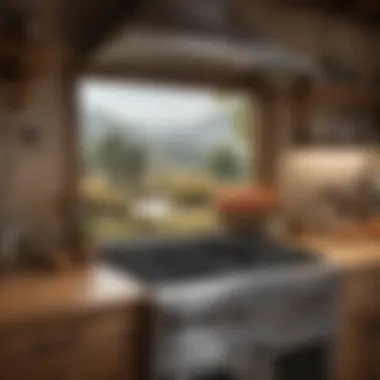
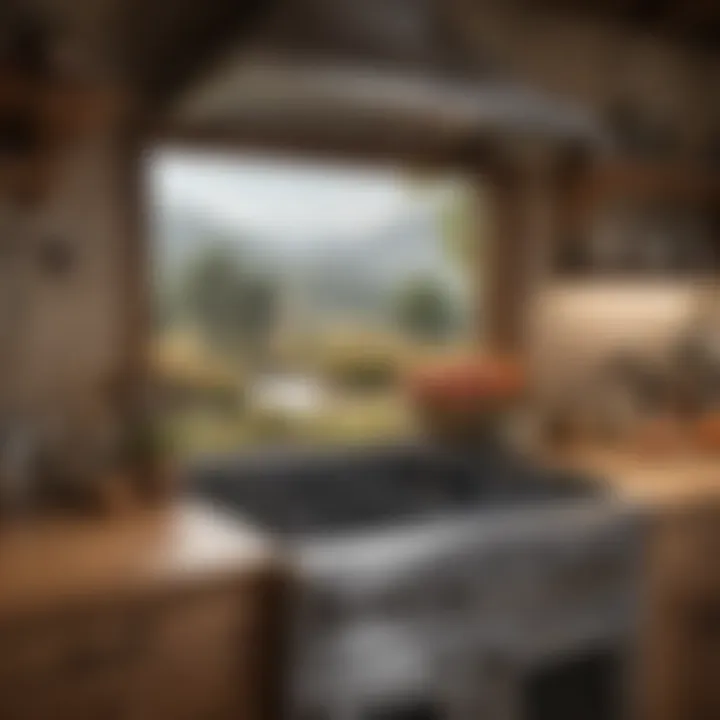
Protection from Stains
One of the primary benefits of backsplash murals is their protective function against stains and spills. In a kitchen, liquids inevitably splatter, whether from cooking, cleaning, or food preparation. Without proper protection, walls can become marked or permanently stained over time.
Murals, made from materials such as ceramic tile or glass, create a barrier that is easy to clean. For example, a ceramic tile mural can withstand heat and moisture, ensuring that it remains intact and visually appealing even in high-traffic cooking areas. This protection is crucial for maintaining the kitchen's aesthetics and keeping the home in good condition.
In addition, murals can be designed to enhance the kitchen's theme while providing this necessary protection. Choosing darker colors or complex designs may help camouflage minor stains, allowing homeowners to enjoy their kitchen without constantly worrying about cleanliness.
"A good backsplash mural not only serves a purpose but also tells a story about the kitchen's character."
Easier Cleaning and Maintenance
The ease of cleaning and maintenance associated with backsplash murals cannot be overstated. Kitchen environments require surfaces that can handle frequent cleaning without degrading. A proper backsplash mural is resistant to common kitchen generating issues such as grease, dirt, and moisture.
For instance, glass and mosaic murals can be wiped clean with minimal effort. This quality makes them highly desirable for family kitchens or homes where cooking is an everyday activity. Instead of scrubbing delicate paint or wall finishes that may chip or fade, homeowners can simply use a damp cloth and mild cleaning solution.
Maintenance also extends to longevity. A well-installed backsplash mural can last for years, reducing the need for frequent replacements compared to standard wall finishes. By investing in durable materials, homeowners save time and money in the long run.
Additionally, proper maintenance of these murals is straightforward. Regular cleaning and occasional inspections can prevent cumulative damage. Homeowners can enjoy a beautiful, functional kitchen that reflects their personal style while staying practical in the face of everyday use.
Installation Process for Backsplash Murals
The installation of backsplash murals is a vital step that determines not only the final look of your kitchen but also the durability and practicality of the mural. Understanding the process is essential for homeowners and design enthusiasts. This section will cover the detailed steps necessary to ensure a successful installation.
Preparing the Surface
Preparation is the first and perhaps most crucial step in the installation process. The surface must be clean, dry, and even. Any pre-existing grease or dirt can lead to poor adhesion, causing the mural to lift or bubble over time.
- Remove Old Backsplash: If there is an existing backsplash, it should be carefully removed. This might involve using a utility knife or a putty knife to scrape off the tiles, and special care should be taken not to damage the wall behind.
- Cleaning: Once the old tile is removed, the surface should be scrubbed to remove any adhesive residue and dirt. A mixture of warm water and a small amount of vinegar can be effective here.
- Smoothing the Surface: If the wall has imperfections, these should be filled with a suitable wall compound and sanded down until smooth. Using a level can help ensure the wall is even, which promotes better mural adherence.
After preparing the surface, let it dry completely before moving to the next step.
Applying Adhesive and Positioning
Once the surface is ready, the next phase involves applying adhesive and positioning the mural. This step is critical as it directly impacts how well the mural will adhere and the overall aesthetic upon completion.
- Choosing the Right Adhesive: The adhesive used will often depend on the type of mural. For ceramic tiles, a thin-set mortar may be suitable, while peel-and-stick options generally come with their own adhesive backing.
- Applying Adhesive: Spread the adhesive evenly onto the wall using a trowel. Ensure the layer is not too thick, as this can lead to lumps under the mural.
- Positioning the Mural: Begin positioning the mural sections carefully. It's advisable to start from the center or from one end, depending on the design. Use a level to check if everything is aligned properly.
- Pressing and Securing: Once positioned, press the mural firmly against the adhesive. For tiles, you may need to use spacers to maintain even gaps between each piece.
Sealing and Grouting
After the mural is affixed, sealing and grouting are essential for both aesthetics and protection.
- Letting It Set: Allow the adhesive to cure as per the manufacturer's instructions. This typically takes at least 24 hours.
- Applying Grout: If the mural consists of separate tiles, grout should be applied in the spaces between. Use a grout float for even application, ensuring to wipe away any excess before it dries.
- Sealing the Edges: Once the grout has cured, apply a suitable sealant around the edges to protect against moisture and stains. This is especially important behind a stove where splatters are common.
- Final Inspection: After everything has cured, perform a final inspection to ensure there are no gaps, and all areas are well-sealed.
"Proper installation ensures longevity and functionality of backsplash murals while enhancing the beauty of the kitchen space."
By following these steps, one can achieve a professional look for a kitchen stove backsplash mural while maximizing its practicality.
Ultimately, taking the time to prep properly, position the mural accurately, and seal it well will pay off in terms of both aesthetic appeal and function.
Maintenance and Longevity of Backsplash Murals
Maintaining kitchen stove backsplash murals is crucial for their longevity and visual appeal. These murals not only serve as artistic elements but also protect the wall from grease and moisture. Proper care can ensure that they remain vibrant and functional for many years. The choice of materials plays a significant role in how much maintenance is required. Some murals are easier to clean and repair than others, depending on their surface and design.
Cleaning Techniques
Keeping backsplash murals clean requires specific techniques suited to the material used. Regular cleaning prevents the buildup of grime and stains. Here are effective cleaning methods:
- Mild Detergent Solution: Use a mixture of warm water and mild dish soap. This is suitable for most tile and ceramic surfaces. Avoid abrasive cleaners that can scratch or dull the finish.
- Soft Cloth or Sponge: Gently wipe the surface. Microfiber cloth works wonders, trapping dust and dirt effectively without scratching.
- Avoid Harsh Chemicals: Some chemicals may damage the surface or finish of the mural. Always check product labels and test in a small area first.
- For Stubborn Stains: A paste of baking soda and water can help lift tough spots without causing harm. Apply it directly to the stain, let it sit for a few minutes, and then scrub gently.
- Sealing: Depending on the material, consider applying a sealant every few years. This enhances protection against stains and moisture.
Repairing Common Damage
Despite best efforts, wear and tear on backsplash murals can occur. Promptly addressing any damage is key to maintaining their aesthetic and function. Here are steps to repair common issues:
- Chip or Crack Repair: For ceramic and tile murals, use a ceramic repair adhesive. Follow the manufacturer’s instructions for application and drying times. This can seamlessly fix minor chips without a visible mark.
- Replacing Tiles: If a tile is severely damaged and cannot be repaired, you may need to replace it. First, carefully remove the damaged tile and clean the area. Then, install a new tile using proper adhesive and grouting techniques.
- Touch-Up Paint: For painted murals, touch-up paint can address small scratches or marks. Match the color as closely as possible for a coherent look.
- Professional Help: When damage is extensive, consulting a professional may be the best option. They can provide expert repair solutions to restore the mural to its original condition.
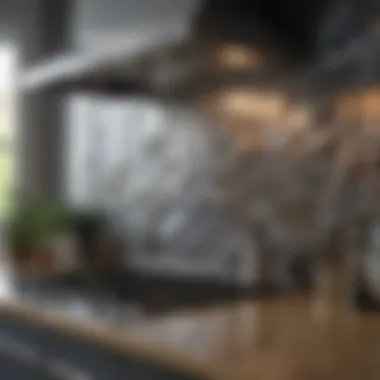
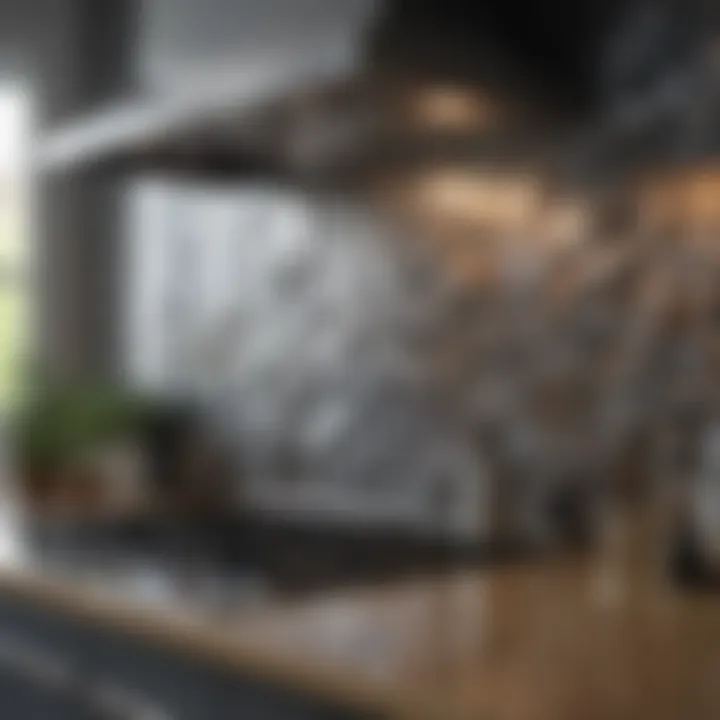
Proper maintenance not only preserves the beauty of your backsplash mural but also contributes to the overall hygiene of your kitchen space.
By following these cleaning and repair techniques, homeowners can ensure that their kitchen stove backsplash murals remain striking and functional over the years.
Cost Considerations for Backsplash Murals
Exploring the financial aspects of kitchen stove backsplash murals is vital for anyone considering this design element. The cost encompasses more than just the initial expenditure on materials. It includes installation, potential repairs, and overall impact on home value. A clear understanding of these factors can guide homeowners in making informed choices while balancing aesthetics and functionality.
Budgeting for Materials
When budgeting for materials, it's essential to explore the various options available. The cost of materials can greatly vary depending on type, quality, and design complexity. Popular options include:
- Ceramic tiles: Generally affordable and available in numerous styles. Prices can range from $1 to $20 per square foot.
- Glass tiles: These tend to be pricier, often costing between $10 to $40 per square foot, but they bring a unique elegance.
- Custom printed murals: These may vary widely based on size and design, starting from $15 to over $50 per square foot.
Assess your budget while considering the overall design of the kitchen, as the backsplash should complement existing elements. Even if a more expensive material is chosen, sometimes it can enhance the kitchen’s value significantly, thus warranting the investment.
Evaluating Installation Costs
Installation costs can fluctuate based on several factors including the chosen materials, kitchen layout, and whether an expert is employed. If you opt for professional installation, expect to pay an additional $10 to $30 per square foot.
Consider these points during evaluation:
- DIY vs. Professional Installation: DIY can save money but requires skill. Mishaps can increase costs later if repairs are needed.
- Complex Layouts: Kitchens with intricate designs or irregular shapes may incur higher installation costs due to the extra labor required.
- Local Labor Rates: Research the costs specific to your area as rates can vary widely across regions.
Ultimately, combining careful material evaluation with a thoughtful approach to installation promotes a budget that aligns with both design aspirations and practical constraints.
Design Trends in
In recent years, the kitchen has transformed into not just a place for cooking but a central hub for social activities. Design trends in 2023 reflect this shift. Homeowners and designers are increasingly focusing on these trends to create harmonious, functional, and stylish spaces. The backsplash is an integral element in this transformation, influencing not only aesthetics but also the overall character of the kitchen. Embracing contemporary trends enhances the functionality of the space while also ensuring it remains visually engaging.
Popular Color Palettes
Color plays a critical role in defining kitchen spaces. In 2023, popular color palettes are moving towards natural and muted tones. Soft greens, warm beiges, and earthy browns are favored, bringing a sense of calm and connection to nature. These hues provide a wonderful backdrop for vibrant accessories and kitchenware, allowing homeowners to express individuality without overwhelming the space.
Additionally, black and navy blue are also making a strong appearance. They offer a bold contrast against lighter cabinetry. This contrast emphasizes the mural and creates a striking visual impact. The key is balancing bold colors with softer elements to avoid a jarring appearance.
Key Trends in Color Selection
- Natural Greens: Evokes tranquility and pairs beautifully with wood elements.
- Earth Tones: Comforting hues that enhance warmth.
- Dark Accents: Create depth and drama in space.
Utilizing these popular color palettes in mural designs can dramatically elevate the kitchen aesthetic, making it feel cozy yet sophisticated.
Sustainable Materials in Focus
As the emphasis on sustainability grows, the use of environmentally friendly materials in kitchen design has become increasingly important. In 2023, sustainable materials for backsplash murals are at the forefront. Homeowners are seeking options that not only look good but also reduce environmental impact.
Materials like recycled glass and sustainably sourced ceramic tiles are gaining popularity. These materials are not only durable but also come in various designs and colors, allowing for a range of aesthetic possibilities. They contribute positively to indoor air quality, making them a smart choice for any kitchen renovation. Design enthusiasts can also find murals that utilize low-VOC paints and eco-friendly adhesives. Such choices align kitchen design with modern ecological practices.
Benefits of Sustainable Materials
- Durability: Long-lasting products that withstand wear and humidity.
- Healthier Indoor Environment: Reduces toxic emissions.
- Unique Designs: Availability of unique patterns that stand out.
Embracing sustainable materials adds value to the kitchen while showcasing a commitment to responsible living.
“Incorporating design trends centered around color and sustainability reflects not just aesthetics but also a wider awareness of our impact on the environment.”
These design trends in 2023 symbolize a shift in values and preferences. They highlight the importance of creating kitchen spaces that are not only favorite gathering spots but also mindful of the surroundings.
Finale: The Impact of Murals on Kitchen Space
In final consideration, kitchen stove backsplash murals serve a pivotal role in enhancing both the aesthetic and practical aspects of kitchen design. They bridge the gap between art and function, offering more than just a visual appeal. By selecting the right mural, homeowners and design enthusiasts can create a distinctive atmosphere that resonates with their personal style and functional needs.
Murals can act as a striking focal point, drawing the eye and creating a unique ambiance. This is particularly important in kitchens where space can often feel utilitarian. By incorporating a mural, one can transform the kitchen into a welcoming space better suited for social gatherings or everyday family meals. The choice of themes, colors, and materials can reflect an individual’s taste and enhance the overall kitchen design.
"Murals add depth and personality to kitchen spaces that often struggle to express character."
Moreover, the practical benefits of these murals cannot be overlooked. Functionally, they protect walls from stains and moisture, making them simple to clean and maintain. This efficiency complements the fast-paced environment typical in kitchens, making mural installations a sensible choice for busy homeowners.
When considering the installation and selection of a mural, factors such as style, theme, and color need careful thought. A well-chosen mural can not only support the current design trends but also create a timeless element that can be appreciated for years.
In summary, incorporating a backsplash mural into kitchen design is much more than a decorative choice. It enriches the kitchen’s environment, making it a reflection of personal style while offering practicality. As homeowners and designers continue to value individuality and functionality, backsplash murals will remain essential elements in the modern kitchen landscape.















